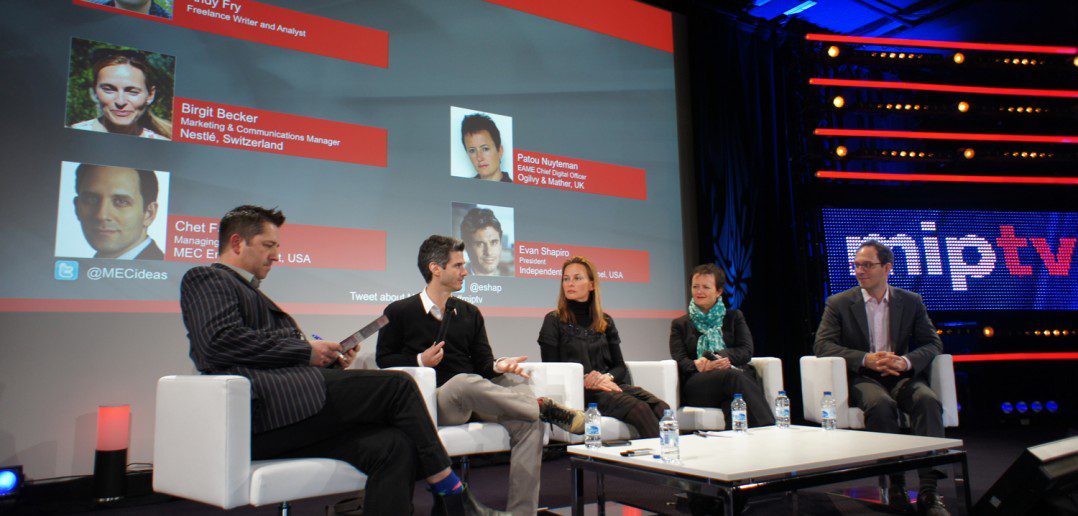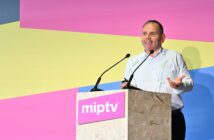[youtube]GLaWhBwYHuU[/youtube]
Speakers: Andy Fry, freelance writer and analyst (moderator); Evan Shapiro, president, Independent Film Channel; Birgit Becker, marketing & communications manager, Nestlé; Patou Nuyteman, EAME chief digital officer, Ogilvy and Mather; Chet Fenster, managing partner, MEC Entertainment.
This discussion on branded content sought to focus on the operational issues that make branded entertainment work in the first place, according to moderator Andy Fry.
Chet Fenster of MEC Entertainment was the first to share his views, sharing a portion of A&E’s Fix This Kitchen, which is a vehicle for showcasing IKEA kitchenware. The show is now in its second season.
Asked whether brands are going in the direction of producing their own TV shows, Fenster replied, “For producers in the audience, what they know is they have to serve the audience first. This is not about making a long-form commercial… the number-one priority is having a compelling story.”
“I’m sure the audience would agree that most commercials don’t do that job very well,” said Ogilvy’s Patou Nuyteman, “but imagine if you could invent branded advertising in today’s age. You don’t have to be limited by a format anymore, you can actually tell that story in a long form.”
Nuyteman elaborated on the importance of making your content great, something worth talking about, because people believe each other more than they believe commercials. “Branded information is something that is really key to the transformation of all our ad agencies… we want them doing way more branded content and branded entertainment,” she said; because that is where their futures are, and the quest for new engagement techniques is ongoing.
To illustrate what she meant, she shared a case study for Ogilvy France’s Autoliberté campaign, Crush Hour.
[youtube]aKeRt2YQ31Q[/youtube]
“We still have a hard time convincing brands to move some budget into this space,” she lamented. “It has to do with measurement, they don’t know how to see the return on investment of something they’ll certainly perceive as more expensive.”
“I do dream a little bit about the fact that brands are going to take this at heart much more strategically,” Nuyteman reflected. “That more strategic acceptance of the importance of creating content that’s going to engage audiences… I think we’ll have to wait a few more years before that becomes mainstream.”
“Brands are broadcasters, and they’re gonna have to figure out how to talk to the consumer and programme to the consumer,” added Fenster with conviction. “I do think that once they have these developed channels or network of subscribers, you need to programme to them.”
“They have rented audiences for years,” Nuyteman agreed. “Actually really owning them, and taking care of them throughout the year” is a significant change that comes with responsibilities that brands are not necessarily ready to assume.
“We’ll see what happens once you own your channel. Or maybe the channels will be managed by the people that do that for a living,” Fenster speculated.
Next up, Birgit Becker of Nestlé shared the Nestlé Infant Nutrition department’s latest engagement project: the 3D reconstruction of Bo the Blue Bear, a baby food mascot that has appeared in packaging and CRM efforts for 40-some years, but has never been standardised or optimised as an emotional asset.
“We first had to convince people that there was huge potential, so we said why don’t we create a 3D bear that is more lively?” she said. “We created a character bible and that was necessary because this character was used by our markets and everybody thought he chould shape it a little bit.” She cited examples of markets putting clothes on Bo; in Asia they even gave him thicker eyebrows to make him look smarter. “With this character bible we wanted to standardise him… give him a specific role, character, a look and feel that is not changeable, because we believe that the impact will be even higher,” she went on.
The reason for the focus on Bo is that he’s made some emotional tremors already. Birgit’s own daughter, now a teenager, has strong connections to him because she had him as a plush toy when she was a girl.
Mothers have also been moved. “The pressure comes from the mums on our Facebook pages. They say, ‘Please can we talk to the blue bear?‘ They want to talk to the blue bear rather than to a logo or a faceless company!” Birgit exclaimed.
“We could also use him in gaming, because he’s not only attractive to mums, he’s also very attractive to babies… A mix of education entertainment, I would say.”
For Nestlé, which Birgit admitted is “conservative”, branded entertainment is still relatively new, but “people are more and more convinced that they must put money behind using this potential.”
The Independent Film Channel’s Evan Shapiro made his case last. He compared branded entertainment strategy to “couch-crashing” because that’s essentially what brands seek to do: piggyback on the good associations of someone else’s content.
“There are times when you want to put your own brand out there, create your own content… but oftentimes brands do very well by borrowing the brand equity or emotional relationship that a network or programme can bring. And that association is like… you’re walking with the coolest kid at the party.”
For the show Portlandia, which has a young, artsy and college-educated following, Subaru approached IFC to see if it could somehow be integrated. The result was a lengthy but well-received scene in which the Subaru is involved but its brand is not mentioned.
“At no point do we talk about the car, do we hard sell the car, but they wanted to be associated with this show because it takes on the hipster mentality,” said Shapiro. “They were really brave. They didn’t tell us what we had to say, and approved what we gave them without changing it in any shape or form. There was another brand in the shot and they were totally cool with it. They liked the fact that they were the center of the humour.”
Shapiro watches shows with Twitter open to see reactions and converse. For this particular script, numerous Tweeters said things like “Subaru inside Portlandia! Perfect match” which was “great for Subaru and great for us,” he said.
Asked whether he’d ever incorporate a poor idea in exchange for big cash, he replied, “It’s very tempting to take the bottom line, but long term you have to think about the asset value… The second you take that, you lessen your long-term asset value, so we try not to lower our editorial standards for that.” Sometimes branded content can take you out of the moment, doing more harm than good, Shapiro added.
But business is business. “At the same time I think our audience understands that we’re in business to make money… You try to keep the editorial as high as you possibly can but you can’t always control that.”
He thoughtfully concluded, “Branding, programming, entertainment, it all comes in one big stew that you take all at once … and I think that’s where we’re headed.”
“For the big stuff, if there’s a big idea for the client and it’s not budgeted… people tend to find money for big ideas,” said Fenster.
“The key is measurement,” Shapiro said. “The weird thing is with TV you don’t measure it by effectiveness, you measure by reach. More and more, a measureable effectiveness in ROI measurement is what the client wants… When you can show effectiveness and give tangible results, that’s when you’re going to see money move from column A to column B.”
“The problem with earned media is that it’s not a guarantee,” Nuyteman protested. “That’s something that brands don’t like… they think it sort of happens automatically and you don’t really have to pay for that,” and for the investment in producing content.
“We’ve worked in the same way for such a long time, and because it comes with new ways of budgeting, setting up resources and ways of working … it’s a big transformation,” she said.
“You have to start teaching this discipline at a very early stage to help unlearn everything we picked up over the years,” said Shapiro, who said it’s important to catch and properly instruct young marketers “in utero.”
In the meantime though, things advance in their own way. The IFC just did a big programme at SXSW with Time Warner, which powered an entire wifi area and turned it into a hangout spot.
“I can crash on their couch just as much as they can crash on ours,” Shapiro said playfully.





2 Comments
Pingback: MIPTV Wrap: Getting hands-on with Branded Entertainment | | MIPBlogMIPBlog
Pingback: The Business of “Branded Entertainment” | Moore Interaction